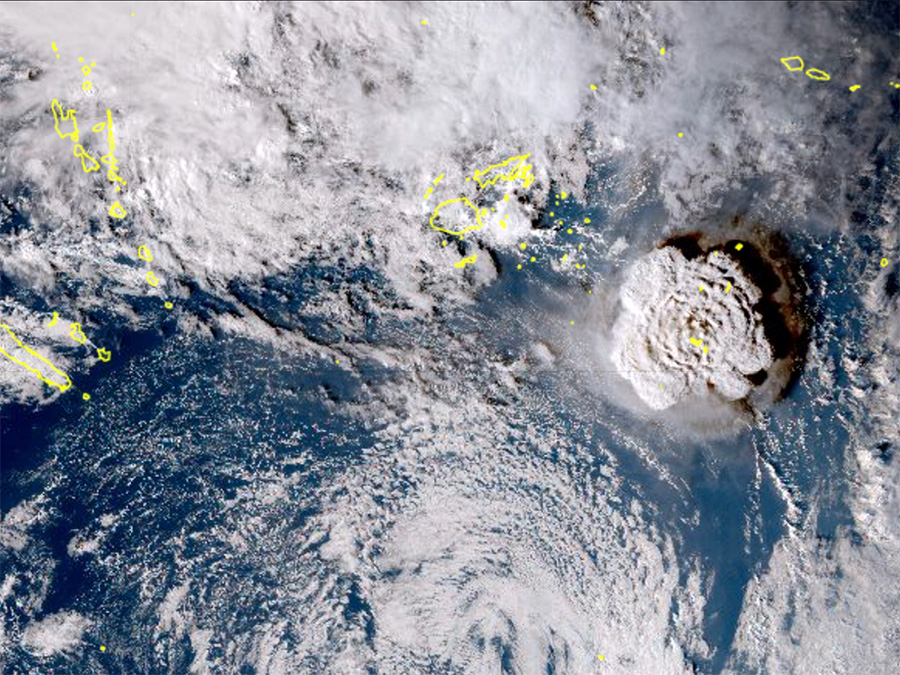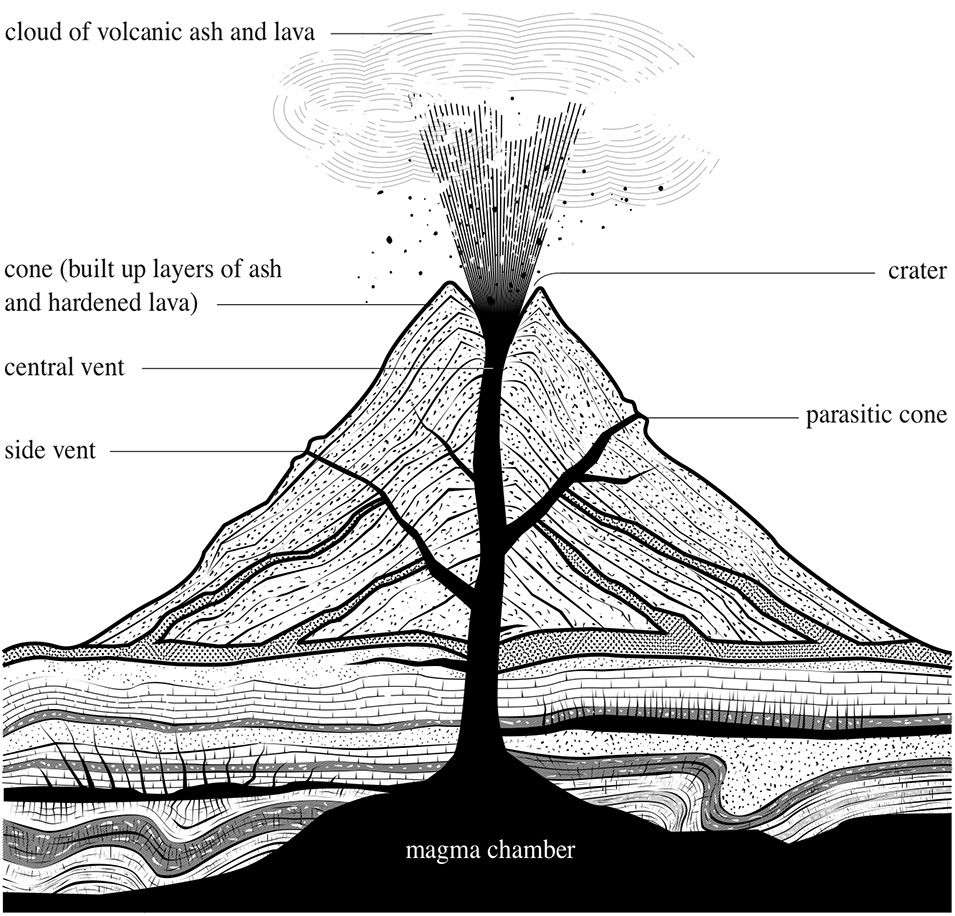Earlier this month, an underwater volcanic eruption near the Pacific Island nation of Tonga unleashed a sonic boom heard thousands of miles away. The explosion generated was really massive. The pressure wave from this has been recorded all around the world.
The devastating wave and toxic ash from the eruption will have long-term impacts on life for residents of Tonga

By Ed Fletcher
Monday, January 24, 2022:
Volcano experts explain the ‘very unusual’ eruption near Tonga and the ‘tsunami genesis’ impact on CaliforniaListen to CapRadio's Insight to hear more on the volcanic eruption on Tonga from CapRadio reporter Ed Fletcher.
Earlier this month, an underwater volcanic eruption near the Pacific Island nation of Tonga unleashed a sonic boom heard thousands of miles away, thrust ash 100,000 feet into the sky and triggered a tsunami with effects felt as far away as the U.S. West Coast.
The devastating wave and toxic ash from the eruption will have long-term impacts on life for residents of Tonga, which is 40 miles from the eruption site. Closer to home, the resulting wave exceeded projections and rocked the marina in Santa Cruz, among other coastal impacts.
To understand why the surge exceeded projections and to learn about this unusually powerful volcanic event, CapRadio’s Ed Fletcher interviewed Bohyun Bahng, a scientist with the National Tsunami Warning Center in Palmer, Alaska, and Michael Poland, a USGS geophysicist with Yellowstone Volcano Observatory.
Here are excerpts of those conversations:
Can you explain what happened to trigger the tsunami?
Michael Poland: There is an underwater volcano [Hunga-Tonga-Hunga-Ha’apai] there that had been showing some intermittent eruptive activity since late December. And then on Saturday [Jan. 14] evening local time, it had a really large explosion.
It did not put that much material in the atmosphere, but the explosion it generated was really massive. In fact, it was heard as far away as at least Alaska, and the pressure wave from this has been recorded all around the world. It also generated a tsunami that, of course, impacted the coast of California, Pacific Northwest, Alaska, Hawaii. It's really seen Pacific-wide, even in Japan. So this is really noteworthy volcanic event.
And what makes it even more interesting from a volcanological point of view was that it wasn't a massive eruption. It was not. A lot of material did not come out of the ground for this, but it generated a really outsized explosion and tsunami for that amount of material that did come out.
Is it unusual for volcanic activity to trigger waves like this?
Bohyun Bahng: It is very unusual. I've been here for 10 years. I've never seen anything like this. Most tsunamis, probably 70 or 80 percent, are triggered by earthquakes, not volcanic activity.
We were not prepared for this type of tsunami genesis. Our operations are based on projecting earthquake-generated tsunamis. Without good models for volcano-driven tsunamis, we were forced to work on the fly. We’re learning a lot from this event and will be better prepared next time.
How is the Tsunami warning dismantled to the people who need the information, including unhoused people living in low-lying areas?
Bohyun Bahng: We disseminate the messages to the state warning points. In other words, the state emergency agencies. It’s up to the state and local agencies to disseminate that message through their normal channels.
Do we know why the eruption resulted in an explosion much larger than scientists expected?
Michael Poland: Well, it almost certainly has to do with the interaction with seawater. We don't have a good handle on the dynamics of magma-water interactions. That's something that we're still learning an awful lot about. And that seems like that probably is what drove a lot of what we saw in this particular eruption. The plume went very, very high, and was a very large eruption cloud for the amount of material that came out. And we've seen this sort of thing in other eruptions that have involved water, especially ocean water, mixing with volcanoes that are right at sea level or just below sea level. So magma-water interaction must have played a huge role in making this such a large explosion.
Are volcanoes like earthquakes? Is one event likely to trigger other eruptions?
Michael Poland: Well, it's possible that we'll see continuing activity at this volcano. Sometimes these volcanoes enter these periods of unrest in which we might see repeated explosions, and that's why this volcano has been active since late December. In fact, there is a pretty decent explosion not near the magnitude, but it was a good size just the day before this really big one. So it's possible that we'll see continued activity at this volcano. But volcanoes don't tend to trigger one another. The effects of eruptions just don't travel that far through the Earth, so we don't expect that this would trigger any other volcanoes to erupt.
Are there local volcanoes people should be keeping an eye on?
Michael Poland: There are absolutely volcanoes in California. There are the Northern Cascades like Mount Lassen and Shasta and Medicine Lake. Clear Lake is an active volcanic area. The Mono Inyo area and the Mammoth area has active volcanism on Salton Buttes. Down near the Salton Sea has some relatively young volcanism. None of these things have erupted particularly recently, with the exception of Lassen in the early 1800s. And then a few hundred years ago, there was some activity among the Mono Inyo Craters sort of north of mammoth. But we have a volcano observatory in California. The California Volcano Observatory monitors volcanoes in California and Nevada, including the ones in the Cascades as far down south as the Salton Buttes.
But yeah, volcanic hazards are a thing in California. It's something that we need to be aware of and monitoring is key to that, making sure that we know what those volcanoes are doing and can anticipate any future eruptive activity.
How much warning or foreknowledge do we have for volcanic activity?
Michael Poland: The good news about volcanoes is they do tend to give warnings. Volcanoes will show some amount of earthquake unrest. They might deform. They might sort of blow up like a balloon as they're swelling due to magma that's accumulating beneath the surface. There can be gas emissions that will change over time. That tells us something about how deep or how much magma there may be beneath the surface. So the key is to be able to recognize these signs when they're still small. And so that's why it's important to have monitoring networks on these volcanoes, even in the quiet times before things really start to get cooking. That way, we can recognize those small signs, and in some cases, we can have weeks to months of warning before an eruption. That's important lead time to be able to prepare for any potential volcanic hazards.
Can any of this be tied to a warming climate or is this just the Earth being the Earth?
Michael Poland: Well, in this case, it's probably the Earth being the Earth. Volcanoes just tend to erupt when they have enough magma in them and enough pressure to get that magma to the surface. And this particular volcano had erupted in 2009 and again in 2014, ’15, and so again now 2021, 2022. So it's been active in the past.
Will this have any long-term impacts on our climate as a result of this?
Michael Poland: We don't expect there to be much in the way of climate impacts from this eruption early on when people were looking at the size of the plume. There was some speculation that this might lead to perhaps a slight impact on global climate. This has happened from past volcanic eruptions that were really, really big, where enough ash and gas was put into the atmosphere that actually caused a small amount of cooling to a degree Fahrenheit or so globally. The last time that really happened was 1991, when the eruption of Mount Pinatubo in the Philippines. But this eruption, even though it was a very impressive one, didn't release enough material to really cause those effects. So we don't expect to see much in the way of a global impact from this.




